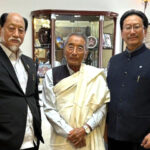What is religion? And what is culture? Religion and culture have separate definitions but their common elements considerably overlap each other in practice. This overlap leads to instances where religious practices become cultural practices to some degree and vice versa. This relationship between religion and culture must be understood and appreciated. Culture interacts with, influences, and is influenced by religion and they are not mutually exclusive. Does that mean one shape the other? Perhaps it is safe to say that religion shapes the culture and in turn gets shaped by the culture. Both religion and culture surround social behavior and affect our value system.
For the sake of this column, religion may be interchangeably used and understood as Christianity. We cannot deny that religious practice (read the Christian faith) promotes the well-being of individuals, families and the community. It is linked to good health, stable family life, strong marriages, and well-behaved children. It even leads to a reduction in the incidence of domestic abuse, crime, substance abuse, and addiction. Social science indicates that religious practice can increase physical and mental health, longevity, and education attainment. These effects are intergenerational, as grandparents and parents pass on the benefits to the next generations.
Now, coming back to the questions above, let us answer them by asking two more questions. How did the spread of Christianity change the Naga society? What impact did Christianity have on Naga culture? We can claim without a doubt that Christianity transformed Naga society and that it has influenced our culture to a considerably high degree. In the process, it would also bode well for us to remember that, as stated above, culture plays a significant role in shaping religious beliefs. Our culture can influence what we believe, how we practice our religion and how we think about or experience religious concepts.
Of all the religions in the world, Christianity is perhaps the most multi-cultural and polyvocal religion. The history of world Christianity shows that it is, from its very inception, a cross cultural and diverse religion. Throughout history, all Christians have lived in specific cultural contexts, which they have, to varying degrees, embraced and rejected. It is in this perspective that we must see Christianity and Naga culture as complementary, not two opposing forces of influence. There are accounts of persecution faced by early Christians and there are also accounts of how ‘religion’ persuaded a number of people to disown their culture. Such mistakes should not happen again. We must try to see that culture subsequently enriches the ‘religious’ experience. It is clear that many interactions take place between culture and religion and they are impossible to separate at a fundamental level. Culture is a manifestation of us seeking to express and understand what is within ourselves and what this life means, and religion is one crucial way in which we find this meaning.
It is impossible to think of the Ao Christian without the Ao, and there can be no Ao without the Ao culture. Therefore, the Ao Christian is inseparable from the Ao culture. That, it can be argued, is a fine way to understand the relationship between culture and religion. As ABAM celebrates 150 years of Christianity in Naga Hills, delegates and attendees have been requested to don ‘traditional costumes’ specifically for the November 2 events. Maybe we already know that the relationship exists; maybe it was always there without us realizing it.



